America's First Total Solar Eclipse Since 2017: What to Know
Written on
Chapter 1: Introduction to the Upcoming Eclipse
In a mere month, North America, including regions in Mexico, the United States, and Canada, will witness a total solar eclipse. This marks the first total eclipse observable in the U.S. since 2017, igniting excitement as the date draws near. This cosmic occurrence promises to be one of the largest communal experiences, so it’s important to keep a few things in mind while planning for April. Continue reading to discover more about eclipses, how to view them, and tips for making the most of this awe-inspiring event.
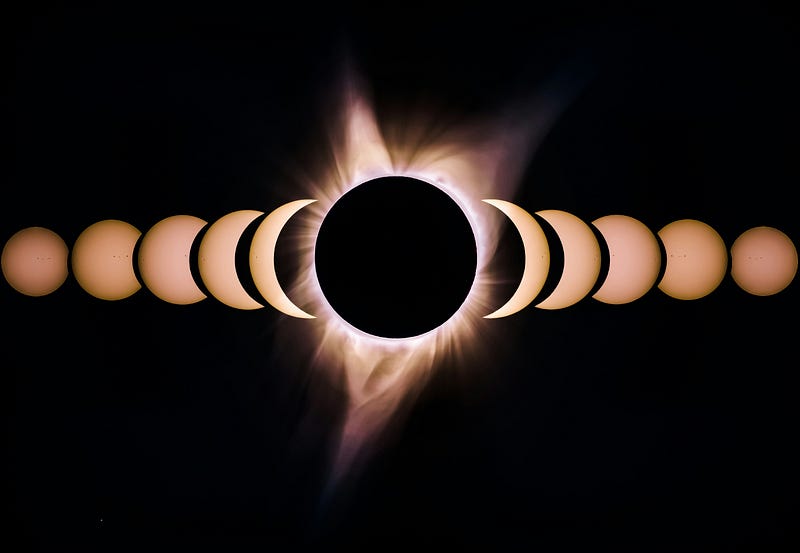
A composite of the phases of the 2017 total solar eclipse over the United States. Credit: Bryan Goff on Unsplash.
What Is a Total Solar Eclipse?
A solar eclipse occurs when the Sun, Earth, and Moon align perfectly. When the Moon passes directly in front of the Sun, it obstructs sunlight, resulting in a solar eclipse. Conversely, during a lunar eclipse, the Earth stands between the Sun and the Moon, casting a shadow on the Moon. These phenomena, particularly solar eclipses, can only happen because the Moon and Sun appear to be the same size from our viewpoint on Earth.
Surprisingly, solar and lunar eclipses occur more frequently than one might think. "Eclipse seasons" emerge roughly every six months. However, if the Sun and Moon appear identical in size, why don’t solar eclipses occur with every new moon, or lunar eclipses with every full moon? The answer lies in geometry.
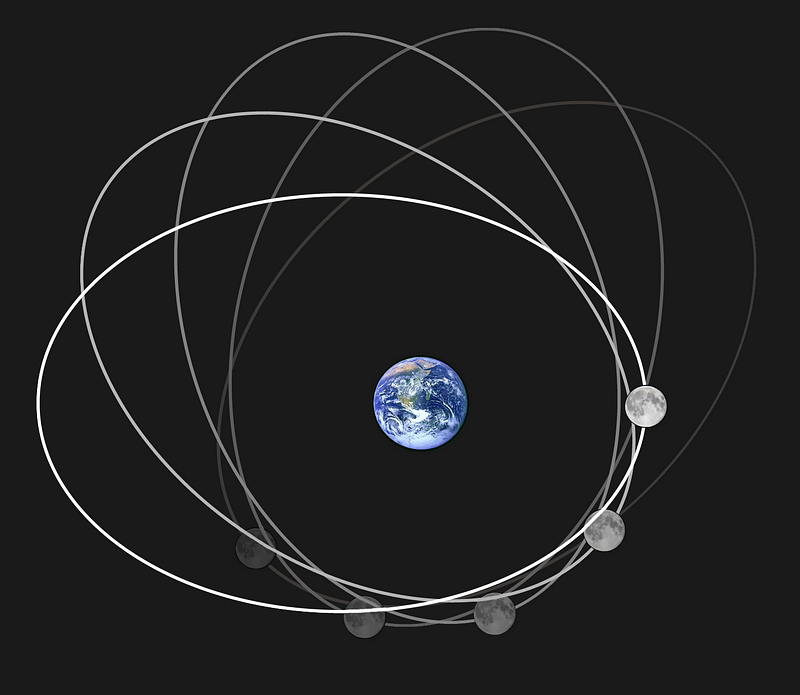
The Moon's elliptical orbit is not static; it changes over time, a phenomenon known as apsidal precession. Credit: Rfassbind on Wikimedia Commons.
Most orbits are not circular. According to Kepler's First Law of Planetary Motion, most orbits are elliptical. When two celestial bodies interact gravitationally, they both orbit a shared center of mass. In the Earth-Sun system, this center is located within the Sun, though not at its center. This results in a relatively stable and low eccentricity for Earth's orbit. Similarly, the Moon's orbit also has low eccentricity, although its distance from Earth fluctuates.
If you’ve experienced a "supermoon," you’ve felt the effects of the Moon's elliptical orbit. A supermoon occurs when the Moon is at its closest point to Earth during a full moon. There are also super new moons, but since they are not visible, they aren't as captivating. For a solar eclipse to occur, the new moon must be within a specific distance from Earth; otherwise, its size will be insufficient to cover the Sun entirely.
For a total eclipse to happen, not only must the Moon be at the right distance from Earth, but it must also align with the Sun perfectly. The Moon's orbit is tilted relative to Earth's orbit, so a solar eclipse can only occur when the new moon's trajectory coincides with the Sun's path on a specific day and location. This geometric requirement makes repeat eclipses at the same site uncommon, even though approximately 2–5 solar eclipses take place annually.
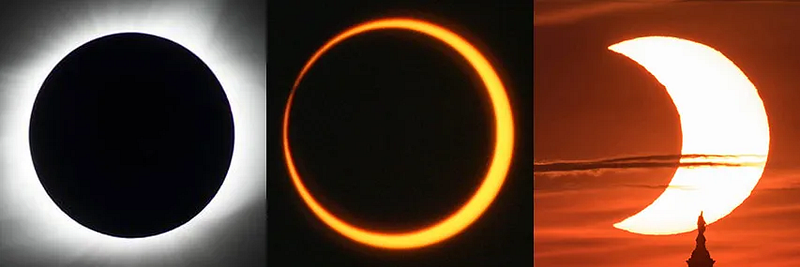
Comparison of three types of solar eclipses: total, annular, and partial. Note that during a total eclipse, the Sun's surface is entirely obscured, revealing its corona. Credit: Total eclipse (left): NASA/MSFC/Joseph Matus; annular eclipse (center): NASA/Bill Dunford; partial eclipse (right): NASA/Bill Ingalls.
If the Moon's path crosses the Sun while it is farther away, an annular eclipse occurs instead. In this case, the Moon obscures part of the Sun, creating a ring of fire effect. An annular eclipse was recently visible across parts of the U.S. last October. Both annular and total eclipses allow regions outside the direct path of totality to experience a partial solar eclipse.
Eclipse Preparation: Travel, Equipment, and Planning
In 2017, certain areas of the United States faced significant challenges due to the influx of visitors traveling to the narrow strip of land where totality was visible. For instance, a drive from Casper, WY, to Denver, CO, which typically takes about four hours, extended to over ten hours on the day of the eclipse. With around 5 million participants, the 2017 Eclipse produced traffic comparable to 71 simultaneous sellout football games. Concerns also arose regarding shortages of fuel, food, and supplies in regions near totality.
This year, similar chaotic conditions are anticipated. Although many states within the path of totality are preparing for an influx of tourists, predicting the crowd size can be difficult due to variable factors like weather conditions. So, how can you ensure you experience totality? Preparation is key.

Totality; the fleeting moment when the Moon entirely covers the Sun. In this image, a solar flare is visible near the top right, emerging from behind the Moon. Credit: Bryan Goff on Unsplash.
If you don’t reside in the path of totality and wish to see more than a partial eclipse, make your travel arrangements promptly. Also, have a contingency plan in case of inclement weather at your initial viewing location. Various science museums, universities, and local businesses along the path of totality will likely host viewing events, so explore your options. Hotels and accommodations are likely to be fully booked or have inflated prices, so thorough research will be necessary.
Regardless of your chosen location for the eclipse, if you find yourself in the path of totality, treat it as an all-day affair. Traffic may become congested in certain areas, so plan to arrive early and depart late. Bring plenty of water and snacks. Consider other essential items like sunscreen, a first aid kit, and rain gear, based on your plans. If possible, fill your gas tank a few days in advance. Most importantly, ensure you have appropriate solar filters for safe viewing of the Sun.
Viewing the Sun Safely
One of the most critical items to have when observing the Sun—whether during an eclipse or not—is proper solar filters. Solar glasses are essential for safe viewing. If you still possess glasses from the 2017 Eclipse, they may be suitable for this event. However, any glasses manufactured before 2015 should not be used, as their filters are likely to have deteriorated after three years, allowing harmful sunlight to pass through. Newer solar glasses can be used indefinitely, provided they remain in good condition. Check for scratches, tears, or holes, and ensure no pinhole light seeps through when held up to the Sun. Look for glasses that conform to ISO 12312–2 (or 12312–2:2015) standards for safety.
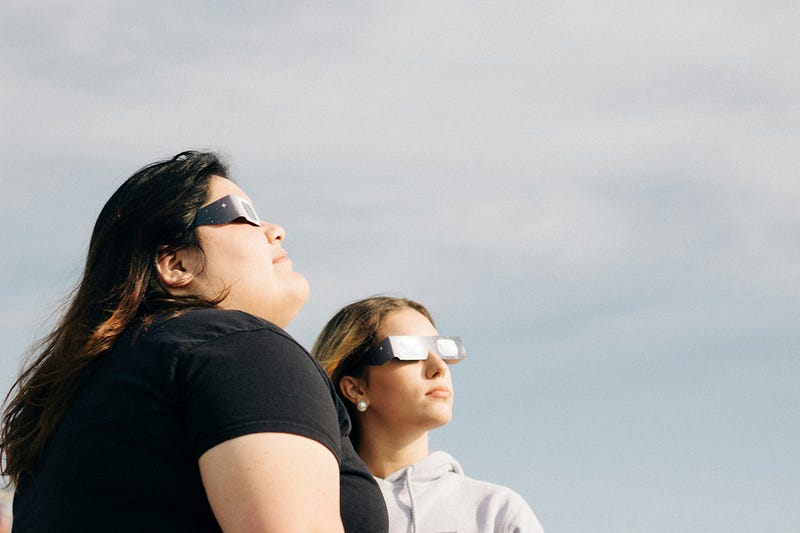
Solar glasses are necessary for safely observing the Sun. Regular sunglasses do not provide adequate protection against harmful rays. Credit: Adam Smith on Unsplash.
Additionally, you will need solar filters for any equipment you plan to use during the eclipse, such as telescopes, binoculars, and cameras. These devices magnify sunlight, making it dangerous to use without appropriate filters. Direct sunlight can also damage expensive equipment. The same ISO standards apply here as well. If you're unsure about your setup or the filters you have, consult with an experienced astronomer. Most major events will have knowledgeable individuals with properly outfitted telescopes who are happy to assist. You can even use your solar glasses to capture smartphone photos.
With only a month to go, solar filters are becoming increasingly scarce. Prices are on the rise alongside demand. New vendors are emerging on platforms like Amazon, selling questionable solar glasses, making it difficult to determine whether they meet the required ISO standards. For safety, I recommend purchasing new glasses only from retailers approved by the American Astronomical Society or through local events.
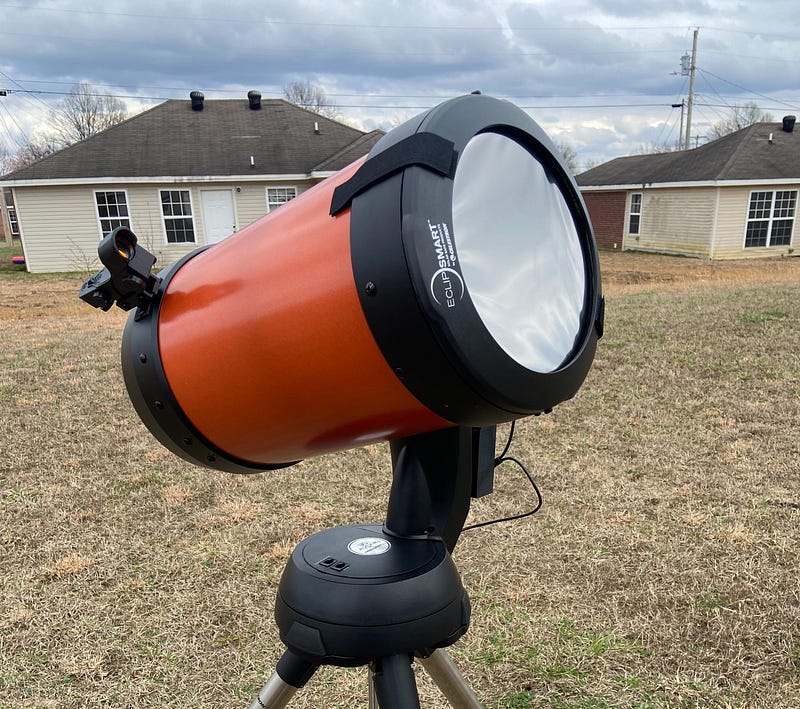
A telescope equipped with a solar filter, secured with backup velcro straps to prevent accidental removal. Note that any magnifying finder scopes should also be appropriately filtered. Credit: Rebecca Jean T.
Lastly, if you are within the path of totality, it is safe to remove your glasses during the total phase. In fact, you won’t see anything if you don’t! Research the start and end times of totality for your location and set a timer or alarm to remind you when to put your solar glasses and filters back on. If using a telescope or other device with fitted filters, consider practicing the removal and reattachment to ensure you can do so swiftly. Enjoy this extraordinary astronomical event! Even if you can't experience totality in person, you may still witness a partial eclipse or tune into livestreams from organizations like NASA to share in the excitement.
For more information, visit NASA’s 2024 Total Solar Eclipse page.
The first video titled "The April 8th Eclipse, What You Need To Know: Unveiling Prophetic Signs In The Heavens | Troy Brewer" provides insights into the upcoming eclipse and its significance.
The second video titled "April 8, 2024 Total Solar Eclipse: Here's what you need to know - Smarter Every Day 295" offers essential information and tips regarding the total solar eclipse.